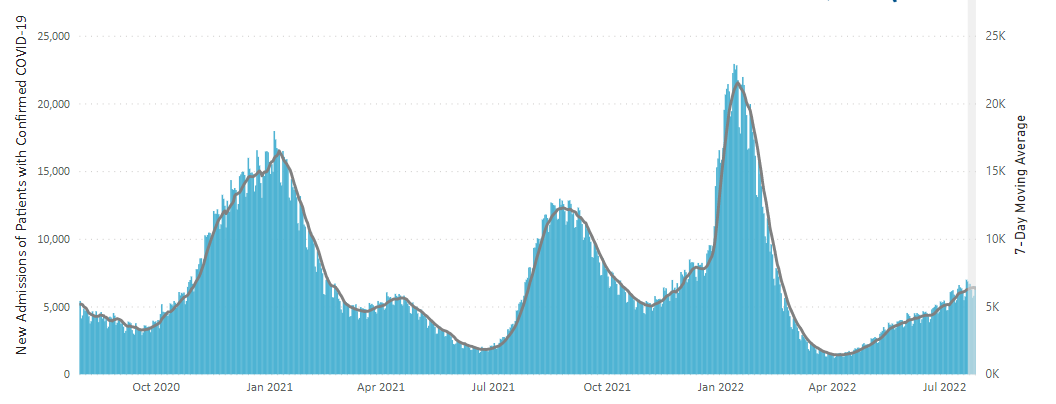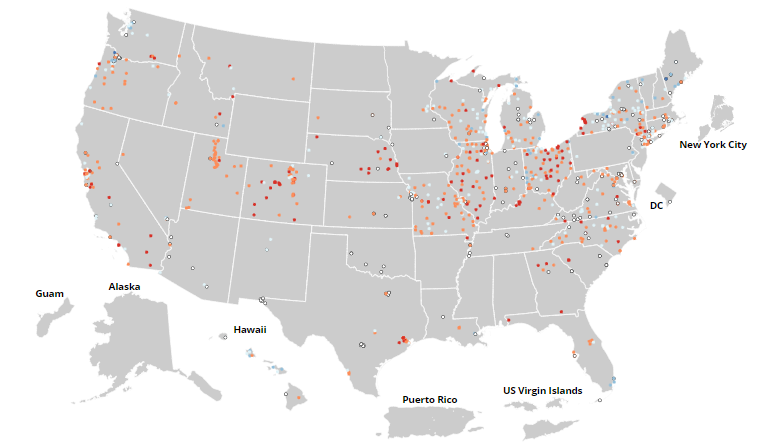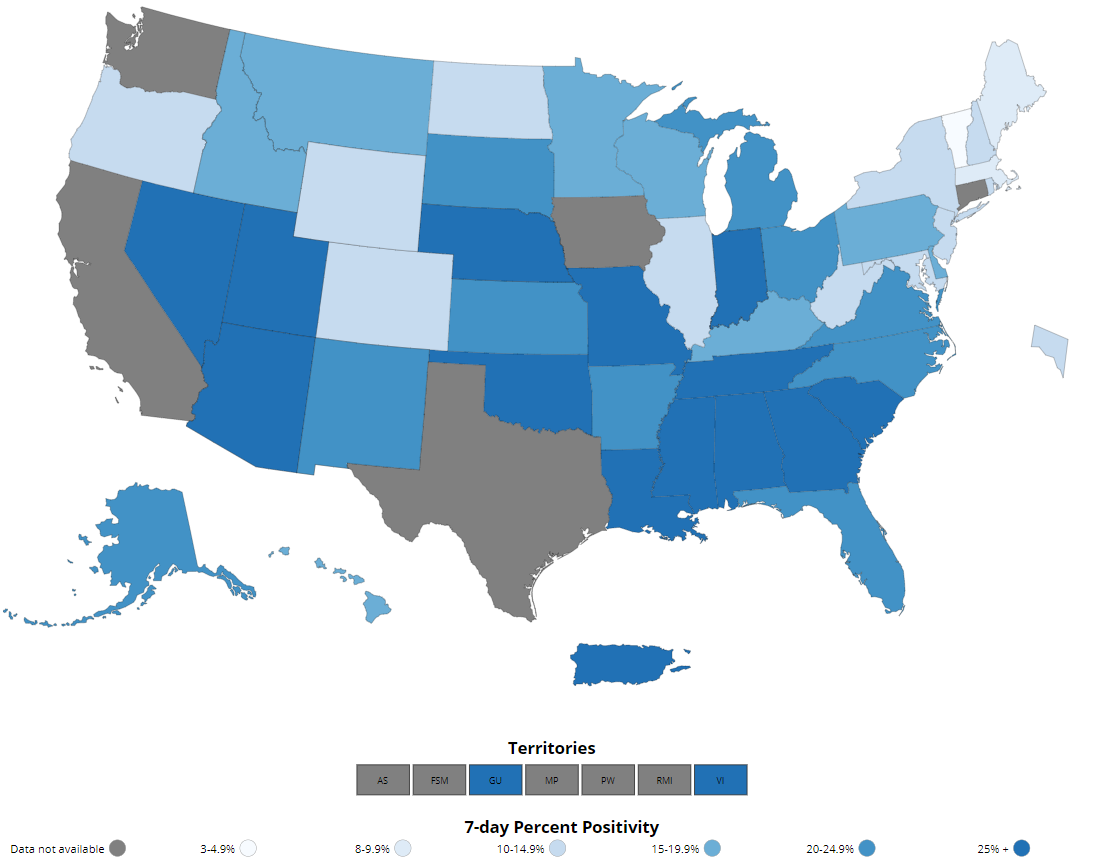Recommendations for Fully Vaccinated People
COVID-19 Homepage
Protect Those Who Protect Us
Interpretive Summary for July 29, 2022
Protect Those Who Protect Us
Nearly two and a half years into the COVID-19 pandemic, cases and hospitalizations have been on the rise, driven by the BA.5 lineage of the Omicron variant. More than a million people in the United States have died from COVID-19, and almost 90 million cases have been reported. The pandemic has taken a tremendous toll on healthcare providers and public health workers, who are dealing with crisis levels of stress and burnout.
A recent CDC survey found that nearly half of U.S. public health workers reported symptoms of at least one mental health condition. Symptoms of post-traumatic stress disorder (PTSD), anxiety, and depression were highest (28%), followed by suicidal thoughts (8%). These symptoms were most common among those who worked more than 60 hours a week or spent most of their time working on COVID-19 response activities. Mental health symptoms were less common in workers who were able to take time off or whose employers increased mental health resources.
These findings highlight the need for public health organizations to protect the mental health of their employees. The federal government is investing billions of dollars in training, research, educational campaigns, and other resources to promote mental well-being in the nation’s public health workforce. The workers who have shouldered the staggering burden of this pandemic deserve all our support.
If you’re a public health worker who needs immediate mental health support, call 988 for the the National Suicide Prevention LifelineExternal or use the lifeline chatExternal to connect with a trained crisis counselor. If you know someone who works in public health, learn to recognize the signs of someone who may benefit from support. CDC has resources to help you and others.
- COVID Data Tracker’s Vaccination Demographics and Vaccination Demographic Trends tabs were updated to display data on second booster doses for people ages 50 years and older by age, sex, and race/ethnicity.
- COVID Data Tracker’s Rates of Laboratory-Confirmed Hospitalizations by Vaccination Status tab was updated to display June 2022 rates of COVID-19-associated hospitalization comparing people who are unvaccinated, people who completed a primary vaccination series, and people with an additional or booster dose. The tab was also updated to include data on second boosters for adults ages 50 years and older.
- Effectiveness of 2, 3, and 4 COVID-19 mRNA Vaccine Doses Among Immunocompetent Adults During Periods when SARS-CoV-2 Omicron BA.1 and BA.2/BA.2.12.1 Sublineages Predominated — VISION Network, 10 States, December 2021–June 2022
- Workplace Perceptions and Experiences Related to COVID-19 Response Efforts Among Public Health Workers — Public Health Workforce Interests and Needs Survey, United States, September 2021–January 2022
- Symptoms of Mental Health Conditions and Suicidal Ideation Among State, Tribal, Local, and Territorial Public Health Workers — United States, March 14–25, 2022
- Safety Monitoring of COVID-19 mRNA Vaccine Second Booster Doses Among Adults Aged ≥50 Years — United States, March 29, 2022–July 10, 2022
COVID-19 Community Levels
As of July 28, 2022, there are 1,474 (45.8%) counties, districts, or territories with a high COVID-19 Community Level, 1,144 (35.5%) counties with a medium Community Level, and 602 (18.7%) counties with a low Community Level. Compared with last week, this represents a moderate increase (+3.9 percentage points) in the number of high-level counties, and a small decrease (−2.11 percentage points) in the number of medium-level counties and also a small decrease (−1.74 percentage points) in the number of low-level counties. 49 out of 52 jurisdictions* had high- or medium-level counties this week. Rhode Island, New Hampshire, and the District of Columbia are the only jurisdictions to have all counties at low Community Levels.
To check your COVID-19 Community Level, visit COVID Data Tracker. To learn which prevention measures are recommended based on your COVID-19 Community Level, visit COVID-19 Community Level and COVID-19 Prevention.
*Includes the 50 states, the District of Columbia, and U.S. territories.
Reported Cases
As of July 27, 2022, the current 7-day moving average of daily new cases (126,272) decreased 0.9% compared with the previous 7-day moving average (127,478). A total of 90,749,469 COVID-19 cases have been reported in the United States as of July 27, 2022.
Variant Proportions
CDC Nowcast projections* for the week ending July 23, 2022, estimate that the combined national proportion of lineages designated as Omicron will continue to be 100% with the predominant Omicron lineage being BA.5, projected at 81.9% (95% PI 79.9-83.8%).
There are several lineages of Omicron and within each are multiple sublineages. The national proportion of BA.4 is projected to be 12.9% (95% PI 11.2-14.7%), BA.2.12.1 is projected to be 5.0% (95% PI 4.5-5.4%), and BA.2 is projected to be 0.3% (95% PI 0.2-0.3%). See COVID Data Tracker for current data.
90,749,469
Total Cases Reported
90,749,469
Total Cases Reported
126,272
Current 7-Day Average**
126,272
Current 7-Day Average**
127,478
Prior 7-Day Average
127,478
Prior 7-Day Average
-0.9%
Change in 7-Day Average since Prior Week
-0.9%
Change in 7-Day Average since Prior Week
*The median time from specimen collection to sequence data reporting is about 3 weeks. As a result, weighted estimates for the most recent few weeks may be unstable or unavailable. CDC’s Nowcast is a data projection tool that helps fill this gap by generating timely estimates of variant proportions for variants that are circulating in the United States. View Nowcast estimates on CDC’s COVID Data Tracker website on the Variant Proportions page.
**Historical cases are excluded from daily new cases and 7-day average calculations until they are incorporated into the dataset for the applicable date. Of 560,662 historical cases reported retroactively, 24,310 were reported in the current week and none were reported in the prior week.
Vaccinations
The U.S. COVID-19 Vaccination Program began December 14, 2020. As of July 27, 2022, 603.7 million vaccine doses have been administered in the United States. Overall, about 261.7 million people, or 78.8% of the total U.S. population, have received at least one dose of vaccine. About 223.2 million people, or 67.2% of the total U.S. population, have been fully vaccinated.* Of those fully vaccinated, about 107.9 million people have received a booster dose,** but 50.1% of the total booster-eligible population has not yet received a booster dose.
CDC’s COVID Data Tracker displays vaccination trends by age group, race/ethnicity, and urban/rural status. To see trends by age group and race/ethnicity, visit the Vaccination Demographic Trends tab. To see trends by urban/rural status, visit the COVID-19 Vaccination Equity tab.
603,693,871
Vaccine Doses Administered
603,693,871
Vaccine Doses Administered
261,654,261
People who received at least one dose
261,654,261
People who received at least one dose
223,245,563
People who are fully vaccinated*
223,245,563
People who are fully vaccinated*
78.8%
Percentage of the U.S. population that has received at least one dose
78.8%
Percentage of the U.S. population that has received at least one dose
67.2%
Percentage of the U.S. population that has been fully vaccinated*
67.2%
Percentage of the U.S. population that has been fully vaccinated*
+0.1
Percentage point increase from last week
+0.1
Percentage point increase from last week
+0.0
Percentage point change from last week
+0.0
Percentage point change from last week
*Represents the number of people who have received the second dose in a two-dose COVID-19 vaccine series (such as the Pfizer-BioNTech or Moderna vaccines) or one dose of the single-shot Johnson & Johnson’s Janssen vaccine.
**Represents the number of people who are fully vaccinated and have received another dose of COVID-19 vaccine since August 13, 2021. This includes people who received their first additional dose or booster dose.
Daily Change in the Total Number of Administered COVID-19 Vaccine Doses Reported to CDC by the Date of CDC Report, United States

7-Day moving average

Hospitalizations
New Hospital Admissions
The current 7-day daily average for July 20–26, 2022, was 6,340. This is a 1.7% increase from the prior 7-day average (6,231) from July 13–19, 2022.
5,035,837
Total New Admissions
5,035,837
Total New Admissions
6,340
Current 7-Day Average
6,340
Current 7-Day Average
6,231
Prior 7-Day Average
6,231
Prior 7-Day Average
+1.7%
Change in 7-Day Average
+1.7%
Change in 7-Day Average
The start of consistent reporting of hospital admissions data was August 1, 2020.
Daily Trends in Number of New COVID-19 Hospital Admissions in the United States

New admissions are pulled from a 10 am EDT snapshot of the HHS Unified Hospital Data – Analytic Dataset. Due to potential reporting delays, data from the most recent 7 days, as noted in the figure above with the grey bar, should be interpreted with caution. Small shifts in historic data may also occur due to changes in the Centers for Medicare & Medicaid Services (CMS) Provider of Services file, which is used to identify the cohort of included hospitals.
COVID-NET: Trends in Hospitalizations among Adults Ages ≥65 Years
CDC’s Coronavirus Disease 2019-Associated Hospitalization Surveillance Network (COVID-NET) shows that for the week ending July 9, the rate of COVID-19-associated hospitalizations (per 100,000 population) for children ages 6 months and younger, who are not eligible for vaccination, is 15.3, a rate 7 times as high as the rate of 2.0 for the week ending April 9. While the weekly rate of hospitalizations for all age groups have increased since April, the rates for children ages 6 months and younger are highest among all pediatric age groups.
Trends in COVID-19-Associated Hospitalizations among Adults Ages ≥65 Years

The Coronavirus Disease 2019 (COVID-19)-Associated Hospitalization Surveillance Network (COVID-NET) is an additional source for hospitalization data collected through a network of more than 250 acute-care hospitals in 14 states (representing ~10% of the U.S. population). Detailed data on patient demographics, including race/ethnicity, underlying medical conditions, medical interventions, and clinical outcomes, are collected using a standardized case reporting form.
Deaths
The current 7-day moving average of new deaths (364) has decreased 4.8% compared with the previous 7-day moving average (382). As of July 27, 2022, a total of 1,023,991 COVID-19 deaths have been reported in the United States.
1,023,991
Total Deaths Reported
1,023,991
Total Deaths Reported
364
Current 7-Day Average*
364
Current 7-Day Average*
382
Prior 7-Day Average
382
Prior 7-Day Average
-4.8%
Change in 7-Day Average Since Prior Week
-4.8%
Change in 7-Day Average Since Prior Week
*Historical deaths are excluded from the daily new deaths and 7-day average calculations until they are incorporated into the dataset by their applicable date. Of 21,756 historical deaths reported retroactively, none were reported in the current week; and none were reported in the prior week.
Daily Trends in Number of COVID-19 Deaths in the United States Reported to CDC

7-Day moving average
 More Death Data
More Death DataTesting
The percentage of COVID-19 NAATs (nucleic acid amplification tests)* that are positive (percent positivityExternal) is increasing in comparison to the previous week. The 7-day average of percent positivity from NAATs is now 18.0%. The 7-day average number of tests reported for July 15–21, 2022, was 494,590, down 12.7% from 566,247 for the prior 7 days.
929,349,291
Total Tests Reported
929,349,291
Total Tests Reported
494,590
7-Day Average Tests Reported
494,590
7-Day Average Tests Reported
18.0%
7-Day Average % Positivity
18.0%
7-Day Average % Positivity
17.5%
Previous 7-Day Average % Positivity
17.5%
Previous 7-Day Average % Positivity
+0.49
Percentage point change in 7-Day Average % Positivity since Prior Week
+0.49
Percentage point change in 7-Day Average % Positivity since Prior Week
*Test for SARS-CoV-2, the virus that causes COVID-19
Wastewater Surveillance
COVID Data Tracker’s Wastewater Surveillance tab tracks levels, changes, and detections of SARS-CoV-2* viral RNA in wastewater at over 1,000 testing sites across the country.
Currently, most of the country is reporting moderate to high SARS-CoV-2 levels in wastewater. Around 53% of sites are currently seeing some of the highest levels for those sites since December 1, 2021. About 40% of all sites reporting wastewater data are experiencing a decrease in SARS-CoV-2 levels, and about 49% are reporting an increase. It’s important to note that even a small increase when levels are low can appear like a dramatic increase in the percent change.
For more information on how to use wastewater data visit CDC’s website.
*The virus that causes COVID-19
SARS-CoV-2 Levels in Wastewater by Site


0% means levels are the lowest they have been at the site; 100% means levels are the highest they have been at the site.





